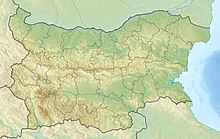Franga Plateau
| Franga Plateau | |
|---|---|
 The historic battle of Varna took place on the plateau. | |
 | |
| Location | Danubian Plain, Bulgaria |
| Coordinates | 43°17′27.6″N 27°49′26.4″E / 43.291000°N 27.824000°ECoordinates: 43°17′27.6″N 27°49′26.4″E / 43.291000°N 27.824000°E |
The Frangen Plateau (Bulgarian: Франгенско плато) occupies the easternmost part of the Danubian Plain (Bulgaria).[1]
Geography[]
To the south and east it descends steeply to the Black Sea and the Varna Plain. To the northeast and north its slopes descend smoothly to the valley of Batova River, which separates it from the .
The plateau measures 20 km from north to south and 22 km from west to east. Its maximum height is 356.2 m in its westernmost part. It is made of Sarmatian limestone and sandstone limestone. There are numerous karst springs on its slopes.
The climate is temperate continental with relatively warm winters and cool summers. It is covered with rare shrubs of oak and hornbeam, accompanied by grassland, along with its grassland and arable land. On its southern and eastern slopes are located villas and resort areas are grown vines. There are 13 settlements on the plateau and its slopes, including Varna. On the eastern slope of the plateau on the steep coast facing the Black Sea are located the most beautiful Bulgarian Black Sea resorts - Golden Sands, Saints Constantine and Helena, Bulgaria, Euxinograd.
History[]
On the plateau are located Varna Monastery and Aladzha Monastery. During the battle of Varna on the plateau, the Ottoman Sultan took a position with the Janissaries. The Crusaders were trapped below on November 10, 1444. Their defeat predetermined the Fall of Constantinople and the discovery of America. Beneath their feet was the oldest gold treasure. And behind the back of the Ottoman Sultan and the Janissaries was the cradle of medieval Bulgaria.
At the site of the battle in 1972 was discovered the Varna necropolis with the oldest gold artifacts in history.
References[]
- Plateaus of Bulgaria